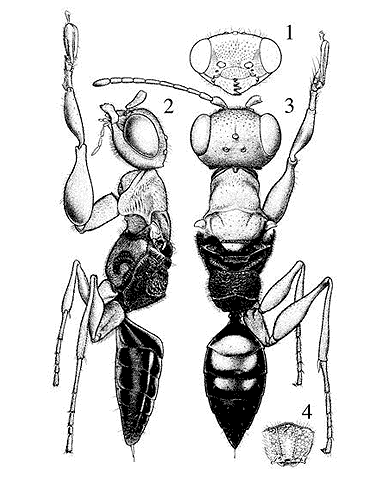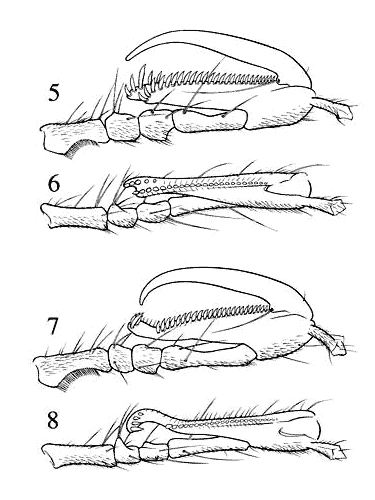Anteon pinetellum, a new Palaearctic dryinid (Hymenoptera: Dryinidae).
J. de Rond
ROND, J. DE, 1998. ANTEON PINETELLUM, A NEW PALAEARCTIC DRYINID (HYMENOPTERA: DRYINIDAE). - ENT. BER., AMST. 58 (7): 133-138.
Abstract: Anteon pinetellum spec. nov. is described after specimens from The Netherlands and the Mediterranean. In recent literature the species was treated as Anteon ephippiger (Dalman).
Beukenhof 96, 8212 EB Lelystad, The Netherlands.
Introduction
Dryinids are a family of relatively small parasitoid Aculeate Hymenoptera. The extremely variable appearance of many species has inspired several authors in the past to describe many new taxa. Kieffer (1914) reported no less than 77 European species belonging to what is now considered the genus Anteon. After Hellén (1919, 1953), Berland (1928) and Richards (1939) had synonymized a substantial part of Kieffer's list, Olmi (1984) reduced the number of European species to 11. The simplified determination keys and the many synonyms that remained unfortunately have raised a considerable barrier for recognition and verification of new species.
abbreviations used;
NHRM = Naturhistoriska Riksmuseet, Stockholm, Sweden.
RMNH = Museum of Natural History NNM, Leiden, The Netherlands.
ZMAN = Institute Systematics and Population Biology, University of Amsterdam, The Netherlands.
Anteon pinetellum spec. nov.
figs 1-6)
Material
Holotype: F., Leuvenum (Gelderland), The Netherlands, swept from Pinus sylvestris L., 17.viii.1996, J. de Rond, coll ZMAN.
Paratypes: 1F. : Leuvenum (Gelderland), The Netherlands, swept from Pinus sylvestris L., 19.viii.1997, J. de Rond; 1F. : Nunspeet (Gelderland), The Netherlands, 19.viii.1987, J. de Rond, malaisetrap material of R.T. Simon Thomas; 1F. : Bussum (Noord-Holland), The Netherlands, 29.vii - 5.viii.1990, J. de Rond, malaisetrap material of J. G. de Rond; 1F. : Gigondas, Beauregard (Dpt.Vaucluse), France, 21.ix.1989, M. J. Gijswijt, coll. RMNH; 1F. : Vizzavona (Corsica), France, 1100-1200 m. near Pinus nigra var. maritima (Ait.) Melville, 6.viii.1971, A.C. & W.N. Ellis, coll. ZMAN; 1F. : Los Monegros (Piña de Ebro, Zaragoza), Spain, 20.viii.1993, light trap, Javier Blasco Zumeta; 1M., 2F. : Benicasim (Castellon), Spain, 22-24.vi.1974, Z. Boucek, coll. British Museum and coll. M. Olmi. At this moment all Dutch specimens remain in the author's collection.

figs 1-4. Anteon pinetellum spec.nov. habitus female; 1, frontal aspect of the head; 2, lateral aspect of the body; 3, dorsal aspect of the body; 4, posterior aspect of the propodeum.
Description
Female: (figs 1-6) Size 3.1- 3.4 mm. General appearance slender.

figs 5-6. Anteon pinetellum, left chela; 5, lateral aspect; 6, dorso-frontal aspect.
figs 7-8. Anteon ephippiger, left chela; 7, lateral aspect; 8, dorso-frontal aspect.
Male: The broad face and obtuse-angled propodeal ridge are similar to those in the female.
Head and propodeum polished and covered with extremely fine and close punctures. On the frons these punctures are separated not more than half the diameter of the anterior ocellus. Antennal segments are of average size. Body black with exception of the bright ivory-white mandibles (without infuscate bases), the yellow-ochre antennae and the dark margined yellow stigmata.
Gonoforcipes (parameres) end in a firm hook and carry a large type dorsal process at the base.
Pronotum short with the incision less well visible than in the female.
Considering the fact that the Spanish female differs from the other females, it is possible that northern male specimens will not correspond with some of the features recorded here.
Discussion
In spite of its superficial resemblance with Anteon ephippiger, A. pinetellum is completely different from all Palaearctic species-complexes within the subfamily. Considering the deep pronotal incision, it is a mystery that the species has not been recognised earlier. Just a shallow impression is present in all other species. The straightened shape of the chelae with two apical lobes is not only unique in Anteon, but even in European Dryinidae. All species of Anteoninae, Gonatopodinae and Dryininae in Northwest Europe display a more or less "S"-shaped fifth tarsal segment (fig. 8), with the distal third bent around the enlarged tarsal claw. One or more short rows of large lamellae are situated at the end of this curl, and are never completely parallel to the basal row. In A. pinetellum, the curl is apparently contracted, and lies side by side to the basal row.
Etymology
The name pinetellum refers to the female's preference for pineforests. The subspecies olmii is named after Professor Massimo Olmi, the first person who published illustrations of the species.
Biology
All Dutch specimens of Anteon pinetellum were collected in dry Querco roboris-Betuletum vegetation, mostly dominated by Pinus sylvestris L. Usually the pines were surrounded with Calluna vulgaris (L.) with Molinia caerulea (L.), Corynephorus canescens (L.) and some patches of Erica tetralix L. The Dutch females identical to the type of A. ephippiger on the other hand, have been found mainly in Salicion albae; wetlands with reeds, nettles and various types of willows. Dragging the vegetation of the location where the holotype of A. pinetellum was found, led to the conclusion that Grypotes puncticollis (Herrich-Schäffer) (Cicadellidae: Deltocephalinae), should be regarded as the most probable host. It is a common species in Dutch diluvial regions and lives exclusively on Pinus sylvestris L. Several dozens of males and females of this planthopper could be swept from the trees during every visit of the location in August. In the Mediterranean, G. puncticollis is also found on Pinus nigra Arnold (Ossiannilsson, 1983). In Southern Europe and North Africa a second species, Grypotes staurus Ivanoff, is living on pine as well (Ribaut, 1952; Nast, 1972). According to the information given by Javier Blasco Zumeta, the specimen of A. pinetellum collected in Los Monegros (Spain) can only be related to Pinus halepensis Miller with G. staurus as the probable host. No other host-parasite records of Dryinidae are known for the genus Grypotes (Guglielmino & Olmi, 1997). The related genus Opsius Fieber, of which the most common European species lives on Tamarisk, may also be a host for A. pinetellum.
Geographic variability
The species is remarkably uniform throughout Europe. The aberrant size and colour of the females from Benicasim are most likely the result of a different host and habitat; the specimens were taken two months earlier than the other females, and it is unlikely that suitable specimens of Grypotes puncticollis are present in June. Moreover, the location is adjacent to the Mediterranean coast, and the possibility that its host lives on Pinus pinea L. is not unthinkable. I prefer to treat the Spanish male and female as the subspecies olmii. It may also be possible that instead of a subspecies, a first of two local generations is involved, as the female from Los Monegros which was taken in August, is more similar to the French and Dutch specimens.
Acknowledgements
I wish to thank Dr. C. van Achterberg for his efforts in requesting type-material and subsequently the curators of various museum for their kind cooperation. I thank Professor Massimo Olmi for determining many specimens and sending his latest publications. Dr. R.T. Simon Thomas, J.G. de Rond and B. Brugge have willingly put their carefully kept malaise-material at my disposal. Dr. C.F.M. den Bieman, J.H. Woudstra Ý and C.A. Schulz added many facts to my knowledge of the genus Grypotes and Javier Blasco Zumeta provided me with the valuable information on Los Monegros.
References
Berland, L., 1928. Hyménoptères Vespiformes. 2. - Faune Fr. 19:1-208.
Burn, J.T. & de Rond, J., (in press). New taxonomic status for Anteon facialis and Anteon pseudohilare (Hymenoptera: Dryinidae).
Guglielmino, A. & Olmi, M., 1997. A Host-Parasite Catalog of World Dryinidae (Hymenoptera: Chrysidoidea). - Contr. Entomology Int. 2: ii, 1-298.
Hellén, W., 1919. Zur Kenntnis der Bethyliden und Dryiniden Finnlands. - Meddn. Soc. Fauna Flora fenn. 45: 277-290.
Hellén, W., 1953. Übersicht über die Bethyliden und Dryiniden Finnlands. - Notul. ent. 33: 88-102.
Kieffer, J.J., 1914. Bethylidae. - Tierreich. 41: 1-565.
Móczár, L., 1983. Dryinid species from Korea (Hymenoptera: Dryinidae). - Acta zool. hung. 29: 181-195.
Nast, J., 1972. Palaearctic Auchenorrhyncha (Homoptera). An annotated checklist: 1-155. Polish Academy of Sciences, Warszawa.
Olmi, M., 1984. A revision of the Dryinidae (Hymenoptera, Chrysidoidea).- Mem. Am. ent. Inst. 37: i-xxxi, 1 1913.
Olmi, M., 1994. The Dryinidae and Embolemidae (Hymenoptera: Chrysidoidea). of Fennoscandia and Denmark. - Fauna ent. scand. 30: 1-100.
Ossiannilsson, F., 1983. The Auchenorrhyncha (Homoptera) of Fennoscandia and Denmark, Part 3. Cicadellidae: Deltocephalinae. - Fauna ent. scand. 7 (3): 594-979.
Ribaut, H., 1952. Homoptères Auchénorhynques II. Jassidae. - Faune Fr. 57: 1-474.
Richards, O.W., 1939. The British Bethylidae (s.l.) (Hymenoptera). - Trans. R. ent. Soc. Lond. 89: 185-344.